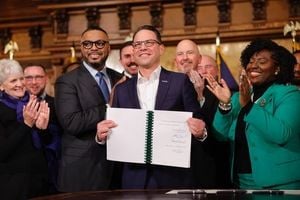In a year marked by renewed efforts to honor and preserve Black history across the Midwest, two communities—Minneapolis, Minnesota, and Brooklyn, Illinois—are at the center of ambitious campaigns to secure national recognition for their historic Black institutions. While Minneapolis celebrates the nomination of three landmark sites to the National Register of Historic Places, Brooklyn, America’s oldest Black town, wrestles with stalled redevelopment projects, federal funding hurdles, and the enduring challenge of keeping its story alive for future generations.
On September 22, 2025, the City of Minneapolis took a decisive step to cement its African American heritage by nominating the Minnesota Spokesman-Recorder (MSR), the Phyllis Wheatley Community Center, and the former home of civil rights leader Harry Davis Sr. for placement on the National Register of Historic Places. According to the Spokesman-Recorder, this move caps a year of exhaustive research led by the city’s African American Heritage Work Group and the 106 Group, whose 223-page study meticulously documents Black contributions throughout Minneapolis from the 1800s to today.
The MSR, Minnesota’s oldest Black-owned newspaper, stands as a pillar of the community. For nearly 90 years, it has chronicled the lives, struggles, and triumphs of African Americans in the state. If the nomination is approved, the MSR would join a small but distinguished group of Black-owned newspapers nationwide recognized as sites of national historic significance. "This would shine a long overdue light on the decades of work the MSR has done to uplift African American voices and secure its place on the national stage," said Tracey Williams-Dillard, CEO and publisher of MSR, and granddaughter of founder Cecil E. Newman, as reported by the Spokesman-Recorder.
The other nominated sites—the Phyllis Wheatley Community Center and the former home of Harry Davis Sr.—reflect the deep roots and enduring legacy of Black life in Minneapolis. The Phyllis Wheatley Community Center has served North Minneapolis for more than a century, offering youth programs, family support, and leadership development. The former home of Harry Davis Sr. commemorates his groundbreaking role as a community leader, civil rights advocate, and the city’s first Black candidate for mayor. "These sites don’t just tell the story of Minneapolis, they are the story," Mayor Jacob Frey told the Spokesman-Recorder.
The nomination process itself was anything but perfunctory. It followed a year-long initiative that not only catalogued historic sites but also gathered oral histories and built a framework for future nominations. If the sites are accepted onto the National Register, they will gain access to preservation grants and tax credits, tools that could ensure their survival for generations to come.
Community pride runs deep. Interim Director Valerie Stevenson of the Phyllis Wheatley Community Center emphasized, "This milestone affirms the resilience and impact of our community and ensures future generations can continue to thrive within these walls." The current owners of the Davis home, Keith Dorsett and Melissa Kadlec, echoed this sentiment: "This house—and Mr. Davis—will have a cemented place in Minneapolis history." For the MSR, the recognition validates what generations of readers have always known: the paper is more than a publication; it is a cultural institution and a trusted voice for nearly a century.
But while Minneapolis moves forward, Brooklyn, Illinois, faces a more complicated path. According to the Chicago Tribune, the town of 650 people—founded in the early 1830s as a refuge for free and enslaved Black Americans—has seen redevelopment projects stall for a second year, hampered by partisan spending battles in Washington, D.C., and the looming threat of a government shutdown. A $2.5 million federal grant intended to transform a vacant brick building at Madison and South 5th streets into a community center has been delayed, leaving the building boarded up and tagged with graffiti.
U.S. Rep. Nikki Budzinski, whose district covers Brooklyn, lamented, "This is a good example of an important community project being held hostage. These communities, and Brooklyn is a great example, are not flush with cash. They’re in need of these federal investments (and) the level of uncertainty is creating anxiety." The Chicago Tribune notes that the anxiety is not new. In January 2025, a feature on Brooklyn’s history and revitalization efforts prompted federal staff to discuss assistance, including the construction of a visitor center and museum. However, excitement quickly faded as it became clear that the Trump administration was not supportive of projects addressing racial history. A spokesperson for Sen. Dick Durbin attributed the lack of progress to “historic cuts to Medicaid, education and other critical services,” blaming the administration and congressional Republicans for stymieing federal investment.
Despite these challenges, Brooklyn’s new mayor, Trenton Atkins, remains undeterred. Elected in April 2025, Atkins has called the availability of federal dollars a “freeze,” but believes the situation will improve. "We’re trying to put ourselves in a position where when things get better, we’ll be ready," he told the Chicago Tribune. Atkins has sought partnerships with major landowners like Norfolk Southern railroad and the Terminal Railroad Association of St. Louis, who have agreed to clear overgrown lots with an eye toward future development. "The railroad has been here for years. And what people don’t understand—the railroad is part of our history," Atkins said. He hopes that one of the newly cleared parcels could eventually house a new fire station and village hall, both of which are currently in poor condition.
Brooklyn’s needs go beyond infrastructure. The town requires new housing, jobs, and businesses to reduce its economic reliance on the adult entertainment industry, which has recently declined. To help chart a sustainable future, the Far South Community Development Corp., a Chicago-based nonprofit, has stepped in to offer expertise on comprehensive village planning. Abraham Lacy, the organization’s president, said, "I’m amazed as an African American and a person who’s pretty astute on history how I didn’t even know about this. I just felt a certain level of wanting, a need, to help." Volunteers are now working on a plan that builds upon last year’s revitalization sessions organized by the Illinois Institute for Rural Affairs.
Federal grant dollars may be scarce, but Brooklyn has benefited from other investments. In July 2025, the National Trust for Historic Preservation awarded a $50,000 grant to the Illinois State Archaeological Survey. This funding supports archaeological excavations and educational programs designed to bolster Brooklyn’s case for inclusion on the National Register of Historic Places. "We’re hoping this could lead to a homegrown archeologist," said Erin Benson, one of the state archaeologists overseeing the grant. The survey team is also working to ensure Brooklyn is included in Route 66 centennial celebrations and pursuing national register status for the town’s Civic Center building, which once served as the "heartbeat of the community," according to architectural historian Laura Shih.
Community events continue to reinforce Brooklyn’s legacy. In September, state archaeologists and the local historical society hosted an event featuring excavations and artifact displays. The historical society also celebrated progress on the Mother Priscilla Baltimore Memorial Walkway, honoring the woman who led 11 Black families across the Mississippi in 1829 to found Brooklyn. The walkway will feature murals, plaques, and a granite monument inscribed with a message of resilience and hope.
As Minneapolis and Brooklyn pursue national recognition, their stories reveal both the obstacles and opportunities facing Black communities determined to preserve their heritage. Whether through city-led nominations or grassroots persistence, the drive to honor the past is as strong as ever—proof that history, once nearly erased, can still shape the future.




